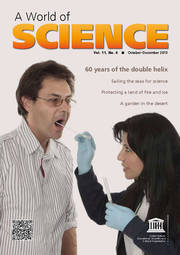Vol 9, No. 4 [October-December 2011]
In Focus
2 Forty years of field laboratories in sustainability
News
13 18 new biosphere reserves
13 UNESCO and ICTP join iTunes U
14 Space tech for heritage gets its own centre
14 World Heritage gains 25 sites
15 A project to improve flood alerts in Pakistan
15 First test of Mediterranean Tsunami Warning System
Interview
16 Tebello Nyokong on using laser to cure cancer
Horizons
18 Chemical contaminants: those invisible additives in our drink
22 Hot ice
In Brief
24 Agenda
24 New Releases
Direct link A World of Science Vol 9 N°4 (PDF document)
See also archives for A World of Science.
Editorial
Laboratories with a difference
In this issue, we celebrate the 40th anniversary of UNESCO’s Man and the Biosphere (MAB) Programme, whose first meeting in 1971 took place against a backdrop of Cold War tensions, a Cultural Revolution in China and nation-building in Africa following independence from colonial powers.
A lot has changed since, not only in geopolitics but also in the way in which we perceive our natural world. The MAB Programme was initially invited by René Maheu, then Director-General of UNESCO, to focus on the ‘general study of the structure and functioning of the biosphere’ and the ‘changes brought about by Man in the biosphere and its resources.’ This was a groundbreaking concept, for, as retired UNESCO staff member Malcolm Hadley relates overleaf, ‘the underlying philosophy behind many national parks [at the time] was that, in order to protect nature, you needed to make it off-limits to the human population.’ Here was a programme that set out to reconcile humanity with the rest of the natural world.
The flagship product of the MAB Programme has been the constitution of a vast network of 580 biosphere reserves in 114 countries. Forty years on, the initial focus on scientific research has broadened to include experimentation in sustainable development, with the growing participation of the private sector. Japanese car-maker Honda, for instance, today supplies complimentary hybrid vehicles to the management teams of Germany’s biosphere reserves to promote its clean, futuristic technology.
Concerns about climate change have come to the fore in recent years, as reflected in the theme of the conference held in Dresden (Germany) in June this year to mark MAB’s 40th anniversary: For life, for the future: biosphere reserves and climate change.
Climate change, biodiversity loss, poverty, deforestation, land degradation: the MAB Programme’s approach to solving these problems can be summed up in two words: sustainable development. Each biosphere reserve is unique, so its approach to sustainable development will also be unique, even if they can also learn from one another. This is the network’s added value.The Sierra Gorda Biosphere Reserve of Mexico, for example, is beginning to attract investors to a project linking more than 260 small-scale farmers, who earn carbon income in exchange for planting trees. The scheme blends efforts to improve farmers’ livelihoods with forest conservation and climate change mitigation.
A survey of more than 100 biosphere reserves by the German National Commission for UNESCO in preparation for the Dresden conference found that these reserves were experimenting in fields as varied as education, natural and social sciences research and renewable energy development for small, local communities.
UN Secretary General Ban-Ki-Moon has made sustainable development his overarching priority for his second term in office beginning in January 2012.
The first test for countries will come in June next year, when the world meets in Rio de Janeiro (Brazil) for the 20th anniversary of the Earth Summit. Let’s hope that UNESCO’s biosphere reserves receive the attention they deserve as experimental grounds for sustainable development.
Gretchen Kalonji
Assistant Director-General for Natural Sciences

